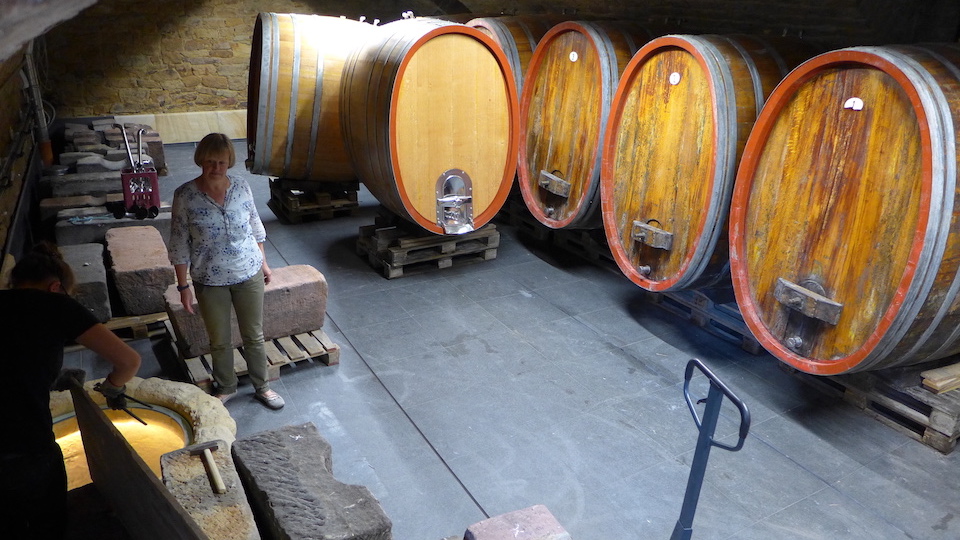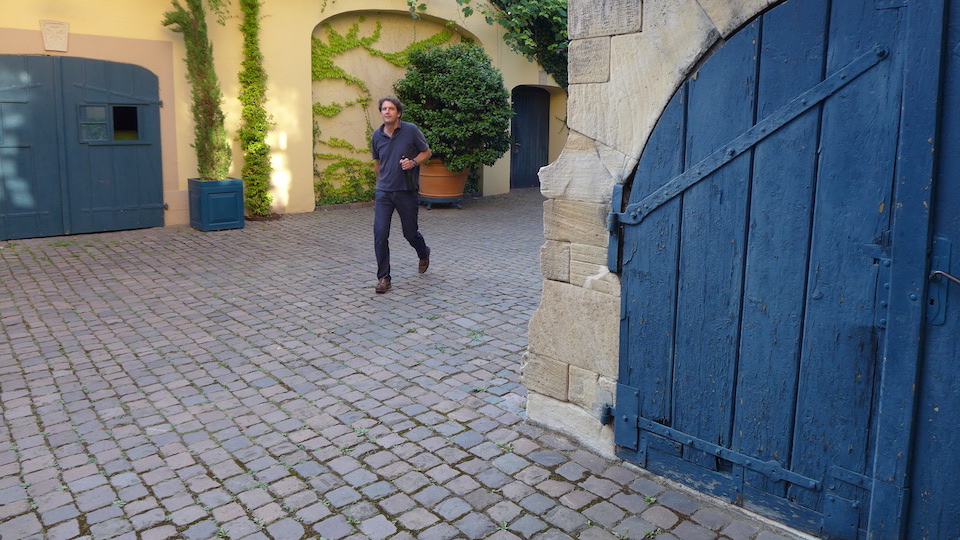Browse using the new Vinous website now. Launch →
Printed by, and for the sole use of . All rights reserved © 2015 Vinous Media
2015 Rhine Riesling: No Pfalz Modesty
BY DAVID SCHILDKNECHT I AUGUST 3, 2017
As I noted in my general comments on vintage 2015 at the beginning of my initial vintage report on Rieslings of the Saar and Ruwer, the Rhine growing regions really experienced two vintages: one for those who harvested most of their fruit in September, and another for those who, like their colleagues on the Mosel, didn’t even get going seriously before early October and weren’t finished before the end of that month. Pfalz vintners were overwhelmingly in the former group, although those in the South (the so-called Südliche Weinstrasse) picked later, as usual, than did those in the Mittelhaardt.
The efforts of veteran growers like Rebholz, Wehrheim, Minges and Messmer and newcomers like Volker Gies have brought the Southern Pfalz (a.k.a. Südliche Weinstrasse) and sites like the Birkweiler Kastanienbusch a notoriety rivaling that of the Mittelhaardt
Another Strong Vintage
The fact that many a Pfalz collection is not notably superior to its much later-harvested 2014 counterpart should by no means be taken as a sign of weakness. Those 2014s, as my extended report on that vintage explains, are very fine. It is unfortunate that their virtues went largely unrecognized early on and were then overshadowed by a bandwagon effect on behalf of 2015. Without question, the aggregate rate of Riesling success in 2014 and 2015 is highest in the Pfalz and Nahe.
The Pfalz not only shared with Germany’s other Riesling-growing regions a summer of exceptionally high temperatures and low rainfall; it experienced them with a vengeance. “Yes, it was hot,” reported Jan Eymael of Weingut Pfeffingen, where at one point temperatures reached 40.2 degrees C. (104 Fahrenheit), “but the heat came on gradually rather than in spikes, so the vines and grapes were able to get used to it.” And vine accommodation probably holds the key to understanding how this vintage of record-breaking heat and drought resulted in Rieslings loaded with bright acidity and dry extract. “How did wines like this emerge from such a hot, dry vintage, and not wines like the 2003s, which was what most people expected?” asked Southern Pfalz veteran Hansjörg Rebholz before offering this explanation: “The difference is clearly accounted for by the overall weather pattern. From the very beginning, the growing season was dry and warm, so the vines prepared to protect themselves accordingly. There was relatively little foliage – we only had to hedge once – and thus fewer leaves to supply with moisture and less surface area for evaporation. By contrast, in 2003 we had a normal, wet northerly spring and beginning of the vine’s vegetative period, after which summer’s severity took the vines by surprise and sent them into shock. “But it’s also true,” added Rebholz, “that we have some drip lines nowadays in Kastanienbusch” that weren’t even allowed in 2003, “and we had to transport water [by tank] to all of our younger vines. It took two million liters.” (For the most part, irrigation is not – or at least, not yet – a significant factor in German vineyards.)
Rain finally arrived with the second week of September, ushering in dramatically cooler weather. But the extent to which Pfalz Riesling vineyards could benefit from that rain differed significantly depending on sector and viticultural regimen. In keeping with his rather radical approach at Reichsrat von Buhl, former Bollinger chef de cave Mathieu Kauffmann had his crews closing in on the Mittelhaardt’s most celebrated sites already in mid-September. As he likes to say, “If the grapes taste good, they’re ripe; I don’t need to look at the analysis to tell that nature has done well,” and by that time nature clearly already had.
“We could have let the grapes hang for four more weeks if we’d wanted to,” insisted Pfeffingen’s Jan Eymael, “but there was already high ripeness.” Given that the Grosse Gewächse picked on September 22 in this earliest Pfeffingen Riesling harvest on record reached 14% to 14.5% alcohol, one could argue instead that he could not have afforded to wait. And this was from what Eymael describes as his healthiest fruit in a long time, so imagine the pressure of rising must weights in sectors where even a little botrytis was present. True, where the Riesling harvest was delayed in 2015, notably in regions other than the Pfalz, must weights of botrytis-free grapes generally plateaued, while flavors benefited. But given how deliciously most Pfalz Rieslings turned out, and the fact that a few of them are alcoholically challenged, one ought not to second-guess growers’ decisions to harvest at dates that would have been unthinkable at any time during the 20th century.
Sabine Mosbacher and husband Jürgen Düringer of Weingut Georg Mosbacher have demonstrated outstanding recent results, as well as what it takes to renovate a traditional cellar full of Stückfässer
Wind and Rain
Rebholz and other southern Pfalz growers, while only 15 to 25 aerial miles from the Mittelhaardt, experienced something closer to that second, very different 2015 vintage. “The ripe flavors weren’t there yet” by the second week in September, he suggested. “Then it started raining and rained quite a lot. But the nights were cool and there was a steady East wind. And that was the decisive development. After that rain, one already had much better and more intense flavors in the grapes. Then the wind continued and any water that the grapes had taken on rapidly evaporated. Soon we had to watch out that the must weights didn’t get too high” as a result of desiccation. The high, ripe acidity of vintage 2015 applies as much across most of the Rhine as it does on the Mosel. Gregor Messmer, also in the Southern Pfalz, speculated that the Riesling berries having been so tiny and their skins so thick not only helped them to resist the summer sun but also to avoid getting pumped with water and diluted from the September rains. As to why the acidity tastes so ripe, reflecting a preponderance of tartaric over malic acid, that’s a bit more of a mystery. But the facts are supported by data. “Our acids were generally 80% tartaric,” noted Eymael of his 2015 crop, “whereas usually we’re happy if malic and tartaric acidity are 50-50.”
As I mentioned in my earlier introductions to reports on this vintage, 2015’s high acidity and prominent phenolics could come back to haunt the wines in bottle, as happened with 1990. But not only is the aforementioned high ratio of tartaric acid in the Pfalz a reassuring sign, this is also the one German Riesling region (in common with Alsace) whose 1990s did not collectively display an obvious post-bottling descent into awkward angularity and unexpected greenness of flavor. So stock up on Pfalz 2015 Rieslings (the year was less consistently kind to Pinot Blanc, Muskateller and Scheurebe) but don’t neglect remaining retail or winery stocks of the impressive 2014s.
Recently completing his 15th vintage at Müller-Catoir, Martin Franzen long ago ceased having anything to prove; but he energetically maintains this estate’s venerable reputation
This report is based on my September 2016 visits to 15 Pfalz growers, supplemented by subsequently tasted sample bottles. Details regarding conventions followed in my reports for describing and rating wines can be found in my initial vintage 2015 report that covered the Saar and Ruwer, as well as in my reports on the 2014 German Riesling vintage. I will shortly publish reports covering vintage 2015 in Rheinhessen, the Nahe, Rheingau and Mittelrhein.
You Might Also Enjoy
Rieslingfeier – The 2017 Seminars, David Schildknecht, July 2017
Rieslingfeier: A Celebration of Germany’s Greatest Wines, David Schildknecht, July 2017
Mosel 2015: Rain in the Nick of Time, David Schildknecht, June 2017
Saar and Ruwer 2015: Rain in the Nick of Time, David Schildknecht, May 2017



